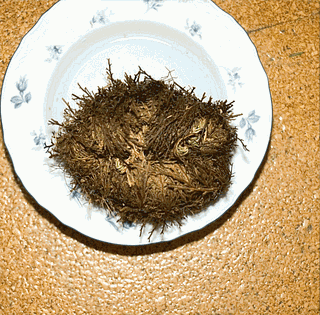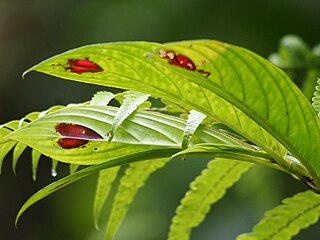| Haberlea | |
|---|---|
 | |
| Haberlea rhodopensis | |
| Scientific classification | |
| Kingdom: | Plantae |
| Clade: | Tracheophytes |
| Clade: | Angiosperms |
| Clade: | Eudicots |
| Clade: | Asterids |
| Order: | Lamiales |
| Family: | Gesneriaceae |
| Subfamily: | Didymocarpoideae |
| Genus: | Haberlea Friv. |
| Species: | H. rhodopensis |
| Binomial name | |
| Haberlea rhodopensis Friv. [2] | |
| Synonyms | |
Haberlea ferdinandi-coburgii [2] | |
Haberlea is a monotypic genus [3] of flowering plants in the family Gesneriaceae. The only member of this genus, Haberlea rhodopensis, is endemic to parts of Bulgaria and a small part of northern Greece, especially in the Rhodope Mountains. [4] Common names include Orpheus flower and resurrection plant because of the remarkable ability of Haberlea to survive very long periods of desiccation. [5]
Contents
- Botany
- Evolution
- Etymology
- Uses
- Medicine
- Cosmetic
- Art and symbolism
- Legends
- See also
- References
- Bibliography
The species is a stemless, evergreen perennial found in north-facing rocky habitats. Basal rosettes of dark green leaves bear trumpet-shaped flowers in shades of white, violet or purple in spring and summer.
Despite the zygomorphic nectar-producing flowers (which are considered an ancestral character) and the overall trend in Gesneriaceae, resurrection plant is only rarely pollinated by bees and does not have specific pollinators. Rather its evolution has switched in the direction of providing pollen as a reward and generalisation of pollinating insects - a trend that is observed in the other European member ( Ramonda ) of the more tropically and subtropically spread family Gesneriaceae. Active pollinators of Haberlea are found to be syrphids (hoverflies) and Lasioglossum morio (Hymenoptera, Halictidae) which are characterised by low preferential behaviour regarding the plants that they visit for food. [6]
Haberlea rhodopensis (pale lilac flowers) has gained the Royal Horticultural Society's Award of Garden Merit. [7] [8]
Haberlea rhodopensis, also known as Orpheus flower, resurrecting flower, and Rhodope Silivryak, is a rare ancient relict flower, endemic to the mountain tops of Bulgaria. There are approximately 20 areas in Bulgaria where Haberlea rhodopensis grows in nature. It can be found at various altitudes up to almost 2000 meters above sea level. Most locations are found in the Rhodope Mountains of Bulgaria and the southern slopes of Northern Greece but smaller populations are also found in Stara Planina region of Bulgaria. The extent of occurrence is estimated to be smaller than 20,000 km². Although rare and protected, the overall population trend is stable, and the habitat is not threatened.
Haberlea rhodopensis and approximately 350 other plant species are called ‘resurrection’ plants. The Orpheus flower is among the most interesting and rare representatives of Bulgarian flora, and a unique plant in many ways. It possesses a property unique among flowering plants (angiosperms) to survive extreme and prolonged dehydration, falling into an anabiotic state that mimics death. It was documented about 70 years ago that Haberlea rhodopensis can survive three years in an herbarium. When the water is available again, the plants can recover (resurrect) in less than two days and have full restoration of all activities.
















